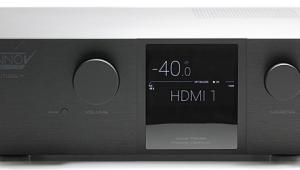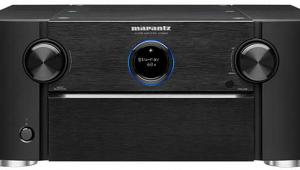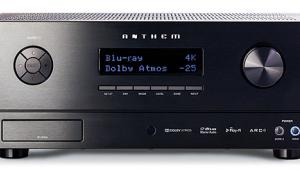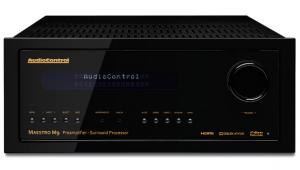Who would pay $6,000 for a surround processor? You and I, if we could afford it.
It's usually Stereo Audiophiles who won't blink at a $6,000 Stereo preamp, while Videophiles choke at the thought of paying more than $2,000 for an A/V receiver. That fact is what makes NAD M17 V2 a tough sell. Nonetheless, V2 it's worth every penny now with Dirac live. In my opinion only Anthem's ARC and Dirac are to be considered premiere room sound correction software for surround processing.
My problem of course is that for $6,000 I would be very close to being able to purchase a fantastic Native 4k projector (JVC NX5). And, as most Videophiles will confess, a quality Display (TOP END OLED/LED or projector & Screen), and Subs will always take precedent over preamp processor and Amps. This is why A/V receiver outsell separates by multiples.
Now, if the budget permits, NAD M17 should be the choice.
NAD M17 V2 Surround Preamp/Processor Review Page 2
There are innumerable other options. DTS simulation modes are available, but one of them referred to in the manual, Neural:X, requires a firmware update that was not yet available at press time. You only need access these special modes once for your preferred settings and save them in one of the five available Presets (for a power user, five presets may not be enough!). Or you can do as I did—leave all selections in the Listening Modes menu set at "None," which will play all sources in their native form with no creative simulations. You can also create macros to execute a string of up to 64 steps with a single key entry on the remote.
 Music Performance
Music Performance
Unless noted otherwise, all of the listening observations in this section, both stereo and multichannel, were made using a single Revel B15 subwoofer and without Dirac Live EQ. If I had to choose one word to describe the sound of the M17 V2, it would be detailed, with clean bass, a see-through midrange, excellent depth and imaging, and an airy but not overly bright top end. Okay, that's more than one word, but I couldn't help myself. Two CDs I often use for evaluation are compilation discs released by speaker maker DALI (neither, to my knowledge, are commercially available). They're awesome recordings, and include unmistakable songs by Holly Cole and Elvis, but also Sinne Eeg and Josefine Cronholm. The vocals, as heard with the NAD, drew me in and encouraged longer listening sessions. Ditto for instrumentals, including a crisp, dynamic take on Toto's classic "I Will Remember," which had a tight opening bass line that grabbed my attention instantly.
Two other CDs are currently fighting for a spot on my desert island list, and the NAD did nothing to compromise their selection. Loreena McKennitt's concert performance, Live from the Alhambra is a three-disc set: 2 CDs and a single DVD. It was compelling listening on the NAD, awash in Loreena's golden voice and flavored by the subtle but unmistakable natural ambience of the surroundings. The only downside for me was her Irish brogue, so thick that even the NAD couldn't sort out all the words!
The CD soundtrack from Kingdom of Heaven is another other desert island choice. It's long been one of the best-sounding CDs in my collection, and the way NAD captured all of its depth and dimensionality was little short of jaw-dropping.
Music Streaming With Bluos
The A/V world is now filled with products that using streaming/multiroom platforms proprietary to different manufacturers, with DTS Play-Fi, HEOS, and BluOS being three of the main players. NAD uses BluOS. (From the M17 V2's manual: "BluOS is a music management software developed by NAD's sister brand, Bluesound.")
I think of BluOS and the others as a system for cataloging the music available from a variety of streaming services, and, if desired, selecting and saving links to that music in your own Favorites lists. I tested it here only with Tidal, using the latter's CD-quality HiFi option.
Once configured, I spent hours surfing through Tidal for music that interested me. I was then able to compare several Tidal selections using my iPad as the controller. While the best Tidal selections sounded very good, they were bettered by the same music on CD as played back on my Marantz UD-7007 disc player. The bass on the Tidal tracks was just as deep, but woolier and louder. The midrange was also a bit clouded (likely by the bass) and the treble less airy and open. Reducing subwoofer level by 4dB and increasing the NAD's treble control (from 0.0 to +2.0) for Tidal playback helped considerably, but for me Tidal still couldn't equal the unaltered CD sound quality.
Tidal also features music in the MQA format. MQA (for Master Quality Authenticated) achieves 96kHz high-res quality at CD-sampling and streaming rates by folding the 96kHz data into a CD-size container and "unfolding" it on playback. The few selections I tried (to be fair, without the above comparison) did sound a little better than standard Tidal HiFi tracks, but not dramatically so.
This isn't a reflection on the NAD. Tidal replay is certainly fine for casual listening, and perhaps fine even for the audio perfectionist to find music that he or she likes well enough to scout out on CD! But I wouldn't use streamed Tidal, as experienced here, to make decisions about other components—or about the true sound quality of the NAD itself, which is clearly exceptional.
Movies Performance
The Greatest Showman is one of the best demo discs in my Ultra HD Blu-ray collection, and its powerful bass met its match in the NAD. Sound effects per se weren't the main attraction here. On the NAD this film's music score, from softly sung solos to rousing, dynamic group numbers, provided everything I could want—and more.
Oblivion features a great score as well, this time mostly electronic. From the opening crescendo to the end credits, it was a delight as heard through the M17 V2. But there is no shortage of searing action here as well, from the takeoff, flight, and landing of a jet helicopter, to nuclear explosions plus a gripping finale. The NAD sealed the deal on all of it.
- Log in or register to post comments






























































